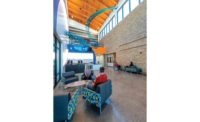An important new women's business center in Afghanistan opened at the end of May. It is aimed at educating entrepreneurs who want to start their own businesses in the war-torn country.
The International Center for Afghan Women's Economic Development is also the new home for the U.S.-Afghan Women's Council, several other nongovernmental organizations and a university program focusing on women's economic development. The center, designed by Denver-based architectural and interior design firm Burkett Design, is located on the campus of American University of Afghanistan (AUAF). It was built down the hill from the bombed-out ruins of the old Darul Aman Palace northeast of Kabul.
"Extraordinary security concerns were weighed when we designed the women's center, such as trying to maintain an open and invigorating campus while keeping it safe and secure," says Amy Burkett, principal at Burkett Design. "We had to determine where to put up guard towers around the campus as well as emergency provisions if basic security were ever compromised."
The center, which was built by international construction and engineering firm Technologists Inc., Rosslyn, Va., includes 10 classrooms, seminar rooms, high-tech audio-visual facilities (including its own radio station), a resource center, computer labs and a 200-seat auditorium. The 50,000-sq-ft building also has a library, a tearoom, roof garden, day-care facility and a workout room. It offers some "calming exterior landscaping," complete with grass and trees. "It's like a small green oasis in Kabul, where there is no green anything," Burkett says. The entire campus had to have its master plan redone since it contained no central quad in place before this project.
Safe Zone
The new business center provides a safe zone for women to network, learn and explore the tools they will need to succeed in the business world, but the program is not just for Afghan women. It also serves male students interested in business who support women in their career goals, Burkett says.
"There really is no opportunity anywhere else in Kabul for [women] to get together and network in a safe environment," says Kitty Yuen, the Burkett Design project manager for the new center.
The main design challenge was meeting the stringent security requirements while bringing in as much light as possible. Some standard aesthetic design elements had to be adjusted to meet security needs, Yuen says. "Initial plans put the new building closer to the main gate area, but we wanted at least a 50-ft blast buffer area," she adds.
The typical "ribbons of glass" office concept for windows also was not an option, Yuen says, again for security reasons. The team had to go with more punched windows, which were bullet-proofed and made smaller to reduce exposure from the outside; all doors and walls are blast proof and the vehicle entrance has double blast-proof doors that allow for full security searches of vehicles before they enter the compound. Guard towers were placed only at the entry points.
"We didn't want it to feel like a prison," Yuen says.
The project team used as many local vendors and materials as possible during construction. The building stone is all local marble and slate, with textiles from local merchants. "We also employed local women-owned firms for the doors and millwork," Burkett says.
The $5-million project was funded by a grant to the Friends of the AUAF from the U.S. Dept. of Defense's Task Force for Business and Stability Operations. The U.S.-Afghan Women's Council is a public-private partnership created in 2002 by then-President George W. Bush and Afghanistan President Hamid Karzai and housed at Georgetown University.






Post a comment to this article
Report Abusive Comment